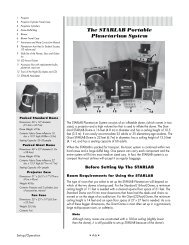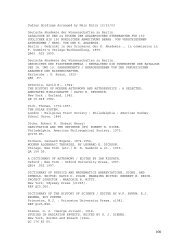K-6 Activities - Dudley Observatory
K-6 Activities - Dudley Observatory
K-6 Activities - Dudley Observatory
You also want an ePaper? Increase the reach of your titles
YUMPU automatically turns print PDFs into web optimized ePapers that Google loves.
Materials<br />
• STARLAB Portable Planetarium<br />
• Projector<br />
• Constellation Cylinder<br />
• Do it Yourself Star Finder (see pp<br />
25, 26)<br />
• Constellation Locator Script (see<br />
Appendix)<br />
Objective<br />
K–6 <strong>Activities</strong> • B–62 •<br />
Circumpolar Constellations,<br />
Activity 4-7<br />
The student should be able to identify the circumpolar constellations on the constellation<br />
starfield in the portable planetarium.<br />
Procedure<br />
• Using the Do it Yourself Star Finder, familiarize yourself with the following constellations:<br />
Ursa Major (Big Dipper), Ursa Minor (Little Dipper), Draco, Cepheus,<br />
Cassiopeia.<br />
• In STARLAB, ask students to identify the Big Dipper. Discuss the idea that the Big<br />
Dipper is part of the constellation Ursa Major, the Big Bear. It can be seen all<br />
year in the northern sky.<br />
• Use the pointer stars at the edge of the Big Dipper cup to locate Polaris. Since<br />
Polaris (North Star) is at the tip of the handle of the Little Dipper, the constellation<br />
Ursa Minor, the Little Bear, is found. It can also be seen all year in the northern<br />
sky.<br />
• Cassiopeia is located on the opposite side of the North Star from the Big Dipper.<br />
Draw a line through the pointer stars to the North Star and continue that line<br />
twice that distance to find the constellation. Nicknamed the Lazy W, Cassiopeia<br />
is found high in the autumn evening sky. In summer it is found in the northeastern<br />
sky and in winter in the northwestern sky.<br />
• Next, move to Cepheus, who is located near his queen, Cassiopeia. The top<br />
side of the Lazy W will point to Cepheus. Cepheus is made up of rather dim (low<br />
magnitude) stars. Its shape is basically a triangle on top of a box. Cepheus is<br />
upside down in the northeastern summer evening sky. He can be found high in<br />
the autumn evening sky and low in the spring sky.<br />
• Finally, Draco, the Dragon, appears next to Cepheus. He wraps his tail around<br />
Ursa Minor (Little Dipper). The stars between the Big and Little Dippers are the<br />
end of the dragon’s tail. The main body of the dragon begins and stretches to the<br />
diamond-shaped head. The legs are very low magnitude stars, so look closely.<br />
Draco is high in the summer evening sky and low in the winter northern sky.<br />
Extension Activity<br />
Go outside at night with your students and use the Do it Yourself Star Finder to locate<br />
these same constellations in the real night sky.





